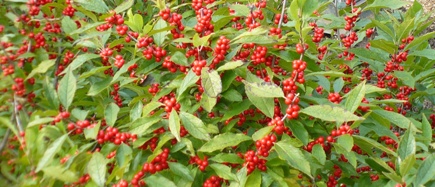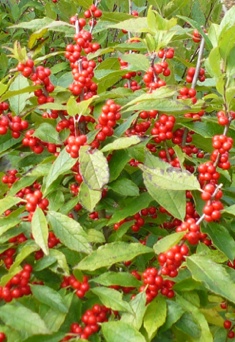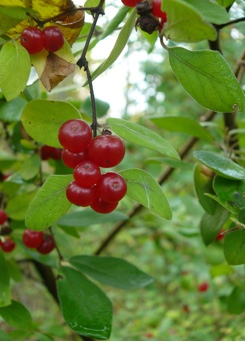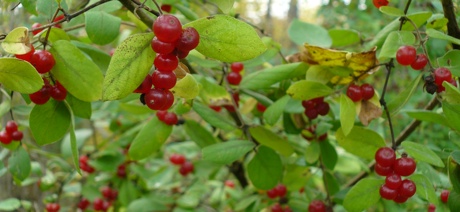The canopy continues to thin here in Sapsucker Woods, leaving the trails adrift in reds and oranges. Oaks and beeches are some of the last holdouts, their leaves providing much of the color in the all-too-soon-to-come winter landscape. However, these leafy slowpokes aren’t the only thing brightening up the grays of late fall; among the most spectacular is an oft-overlooked native shrub that becomes even more beautiful as it drops its leaves. The culprit? Winterberry.

(a thick crop of winterberries)
For most of the year, Common Winterberry (Ilex verticillata) is a nondescript shrub with deep green glossy leaves, but come Fall it sprouts linear clusters of intense red berries that become more prominent as this deciduous holly drops its leaves. It can be found from Nova Scotia to Florida, and west to Missouri, excelling in areas of poor drainage. Around Sapsucker Woods, this is the only native deciduous holly we have, but there is another red-berried plant that it is sometimes confused with: Honeysuckle.


(winterberry on left, honeysuckle on right)
Honeysuckle is one of the most invasive shrubs in the area, forming dense thickets of yellowish-gray striated bark along woodland edges. The superficial similarity to winterberry lies in its possession of juicy-looking red berries, and its shrubby nature. You can find honeysuckle just about anywhere you want to look in Sapsucker Woods; much of the understory on the north side of the pond is composed of either honeysuckle or buckthorn (both invasive berry producers), and both were likely brought to Sapsucker Woods by the very creatures we spend so much time studying, namely fruit-eating birds (though each is likely also a favored treat for another woodland nuisance, the white-tailed deer). Honeysuckles also have the ability to spread vegetatively and some research has suggested that they can poison the chances of other plants through allelopathic interactions.

(light-green patch of honeysuckle)
The thing that all three of these berry producers have in common is the production each year of a heavy crop of berries that are characterized by being “low in nutritional content“. Roughly translated, these berries are the equivalent of a can of coke, offering nothing more than a rush of soluble carbohydrates, and this results in them being eaten later in the season as birds (especially migrating birds) target fat-rich foods. While it might not seem intuitive, berries can also be high in fats, and a selection of other berries in the landscape (dogwoods, sassafras, poison ivy) are relatively high in lipids (fats), and offer something closer to a bag of chips to the migrating masses, and most of these berries are gone by the end of Fall.
Given these intrinsic differences in the “value” of a given berry, it’s fun to think about how a fruit eater might choose to exploit these resources, and it is thought that birds try and eat a mix of sugars, proteins, and lipids for nutritional balance. However, by midwinter, all that might be left for a hungry resident is the equivalent of a can of coke…






This is the kind of detailed natural history post that the Web needs more of: people understanding the specifics of their neighborhood ecosystems. Nice work. I do wonder about the buckthorn you mention – I know that in the South several species of Rhamnus are native. Where did this invasive one come from? It’s sort of tantalizing to hear that they were likely brought to SSW by birds, since that’s not exactly an invasion. Unless, of course, they were brought from Japan by some Rochester-based horticulturist and then ferried over to Ithaca by cedar waxwings or catbirds. Regardless, nice post…
Thanks! European Buckthorn (_Rhamnus_cathartica_) was introduced in the late 1800s as an ornamental hedgerow; it has moved on from a more domesticated setting, “invading” natural areas (along with the honeysuckle) via birds…
[…] my earlier posts lambasting Rhamnus in all its glory, the birds seem to find it an acceptable substitute for a native berry bush. The […]